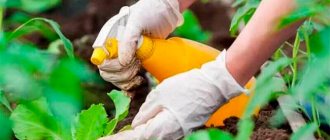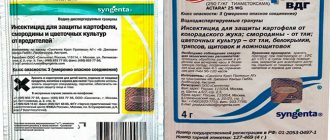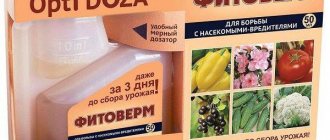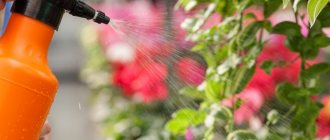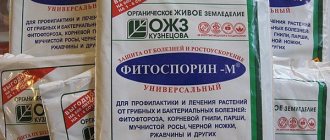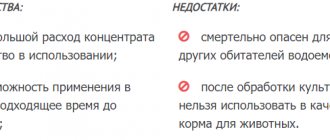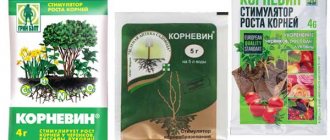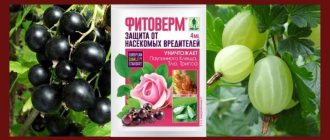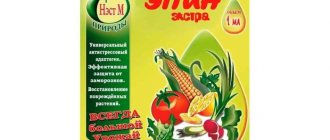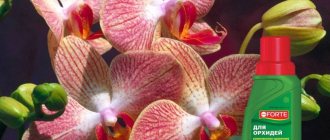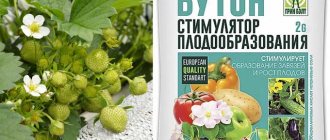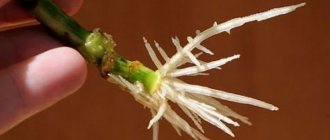Purpose of the drug
Aktara is intended for use as an insecticide from the neonicotinoid group. It effectively controls thrips, lepidoptera, whiteflies, mealybugs, false scale insects, colored potato beetles and aphids on berry and flower crops. The drug is not very effective against whiteflies, and it has practically no effect on arachnid pests.
Aktara is available in various types of packaging
Suitable for indoor plants. Has no effect on resting larvae, pupae, eggs and adults.
Scope of application
The insecticide packaging shows a close-up of the potato beetle, a known enemy of potato beds. However, the range of activities is much wider. Aktara is used against aphids, whiteflies, thrips, bark beetles and many other insect pests. Its effectiveness has been proven against onion flies, cabbage flea beetles and apple moths. Dangerous pests are controlled in several ways:
- soaking the roots of vegetable seedlings;
- processing tubers before planting in the ground;
- application to the soil in beds and flower beds with indoor plants;
- spraying over the entire surface of the above-ground parts of plants.
Spraying plants with Aktara should be carried out when it is necessary to destroy pests that have settled on the site as quickly as possible. Root irrigation is considered the most effective treatment method, since the protective function is maintained for the maximum period of time (on average up to 2 months). Soaking seedlings and treating tubers before sowing can prevent pest attacks.
Composition and release form
The drug contains thiamethoxam (an artificially obtained derivative of normal nicotine) in various concentrations (240 g/kg or 240 g/l) with topping.
Release form: in the form of one percent granules or suspension (concentration 25-35%).
| Packaging format: | 0.25 kg. (10×0.25 kg), bag 0.004 kg. (15×0.004 kg. / 10x15x0.004 kg.) |
| Registrar name: | Limited Liability Company "Syngenta" |
Active substance
The main active ingredient is thiamethoxam. It accounts for ¼ of the weight of the drug, and the share of other useful substances - ¾. Aktara is absorbed into the leaf tissue through the cuticle and into the deep layers of the roots during watering. The drug quickly moves through the vessels and fills all tissues. The insecticide is effective even when the room is hot.
Aktara liquid
Liquid Aktara for the Colorado potato beetle is available in 9 ml bottles or 1.2 ml ampoules. This is a suspension with a concentration of the active substance thiamethoxam of 240 g/l.
Despite the fact that the Colorado potato beetle is depicted on the packaging and is mentioned in the title, liquid actara destroys all pests except mites: aphids, thrips, whiteflies, scale insects, scale insects, false scale insects, poduras, fungus gnats, codling moths, copperheads, etc. The consumption rates are as follows the same as actara in granules.
Since liquid actara is available in 1.2 ml packaging, it is easier to count using a syringe. For example, for currants, dilute the entire ampoule (1.2 ml) in 6 liters of water, for onion flies - 1.2 ml in 3 liters of water, and to cure roses from thrips with actara, you need to dilute 1.2 ml in 750 ml of water.
Principle of pest control
After spraying or watering the soil with an insecticide solution, its active substances penetrate the cells and vessels of all parts of the plant and remain there for a long time. Sucking or leaf-gnawing pests eat poisoned parts of plants or feed on the cell sap of Aktara, thereby poisoning the body of the pest.
The drug acts on receptors in the nervous system and paralyzes them. As a result, insects lose their ability to feed within an hour. Death occurs approximately 5 hours after poisoning.
What pests does it help with?
Effective against pests of indoor plants, garden trees, vegetable crops and open ground flower beds. The list includes:
- ground flies;
- fungus gnats;
- false scale insects and scale insects;
- thrips;
- all types of aphids;
- whiteflies;
- Colorado beetle;
- leafhoppers;
- harmful turtle (bug);
- cruciferous flea beetles;
- mining moths;
- drinker;
- wireworm;
- bread ground beetle;
- cabbage cutworm and cabbage cutter;
- pea codling moth;
- pea grain;
- thrips and others.
When spraying plants, the aerosol hits caterpillars and beetles, then penetrates their body, and the poison begins to act. The insects eat the poisoned plants, ingesting the insecticide, which destroys their nervous systems. After half an hour, the parasites cannot eat anything and soon die. If the insecticide is applied to the soil, underground pests die.
The drug "Aktara" costs 75-100 rubles per pack of 4 grams, and 3.5-5 thousand rubles per 250 grams, respectively. The product should be stored in utility rooms, on high shelves or in closed cabinets. Children and animals should not enter there.
It is not recommended to store food, medicine or feed near the product. The room temperature should be from 10 degrees below zero to 35 degrees above zero. Do not store Actara in places with high humidity.
From the Colorado potato beetle
"Aktara" is a paralyzing poison that acts on the receptors and nervous system of the pest. Within 15-30 minutes, the potato beetle stops eating the plant and dies within 2-24 hours.
Aktara is addictive, so it should be used interchangeably with other insecticides.
It is important to know that Aktara acts differently on different insects. For example, for a bee it represents the first class of danger, and for aquatic and terrestrial insects it represents the fourth.
From aphids
After treatment, the drug is absorbed into the vascular system of plants, shrubs and trees, bypassing the fruits. After treatment, aphids stop eating plants, flowers and leaves.
The active ingredient thiamethoxam completely destroys the ability of aphids to survive within half an hour, so they die within a day.
From spider mites
Spider mites very often attack indoor plants; fighting them is very difficult, and not all remedies are effective. As for Aktara, where the instructions for use for indoor plants indicate that it is not suitable for controlling ticks, it can be used. Some gardeners claim that this helps and the tick dies. However, positive claims about the drug's effects usually refer to the first use. With subsequent spraying, Aktara may not be as effective.
From whitefly
Small whiteflies on orchids spread quickly and infect almost all the plants in the collection. Whiteflies are small insects with folded wings. The body appears to be covered on top with a layer of white powder.
The invasion of this insect causes yellowing and dropping of leaves. The pest makes the plant more susceptible to fungal, viral and bacterial infections.
Start the fight against whiteflies by replacing the growing medium and removing infected leaves. Treat the plants with Actara. Water the soil with a weaker solution.
From ants
Some gardeners speak positively about these insects. They claim that black garden ants are good for both soil and plants:
- in the process of obtaining protein, they fight off many other pests, larvae and caterpillars;
- they are food for birds;
- they pollinate plants and flowers;
- they loosen the soil by making holes in it, providing the roots of plants with oxygen.
From onion fly
Spray the plants against onion flies with a solution prepared from 4 g of the drug and 10 liters of water. Dissolve the granules in warm water (temperature should be at least 25°C).
This volume is designed to process 10 m2. The bulbs are sprayed for the first time when the dandelions begin to bloom, and after 1-1.5 months the plants are sprayed again.
From mealybug
Another mistake that is easy to recognize and difficult to ignore. Also known locally as hair louse. It got its name because of the cotton-like marks that it leaves on the leaves and in the internodes of plants. These are the simplest ways to determine it. The parasite resembles a woodlice, and its larvae resemble small sesame seeds. For some reason, it likes to attack desert rose in late fall and winter.
The pest most often settles on the underside of leaves, young shoots, buds and flowers. It is easiest to detect it at the tops of adeniums, where a large number of individuals accumulate and new leaves become deformed.
Adenium is infected with worms. The photo gives the impression that the plant has been sprayed with water. But in fact, this is the result of the activity of insects - secretions that have formed a sticky coating on the leaves.
From thrips
The difficulty in killing thrips is that this insect goes through four stages of development in different parts of the plant, including the ground.
Treatment is carried out by spraying the soil and spraying every week for a month. The solution is prepared in maximum concentration.
To avoid insects becoming accustomed to Aktara, the last 2 treatments should be carried out with a different group of insecticides.
From scale insects
The shield aphid is a dangerous pest of orchids. Fine brown scales or waxy bumps and sticky discharge on leaves and stems are signs of infestation. Adult pests are difficult to remove because they literally bite into plant tissue.
The length of the insect ranges from 1.5 to 4 mm. Wings develop only in males, but the oral apparatus is reduced. Large females have neither legs nor wings. The waxy scutellum protects well from the penetration of chemicals through the integument into the body.
Scylla and false moths are combined into one superfamily Coccidae or ringworms - sucking insects that are dangerous to many plants. Pests of orchids include 4-5 species of lepidoptera and soft pseudo-lepidoptera. This group of insects is extremely difficult to control.
Before getting rid of scale insects, it is necessary to isolate the affected plant from healthy ones. Then remove all brown tubers. It is recommended to change the substrate, disinfect the pot and treat the orchid. Then it will be necessary to carry out the second and third treatments at intervals of 5-6 days.
Action
The active ingredient of Aktara is thiamethoxam. After 30 minutes from the moment the solution is applied to the plants, the pests lose their ability to feed and die within 24 hours. Thiamethoxam penetrates into plant tissue (but not into fruits) through the vessels, the entire vascular system of the plant in 20 hours. When applied by the roots, the effect of Aktara lasts up to 2 months, and when sprayed on leaves - up to 1 month.
The drug does not react to the action of sunlight; its effectiveness is practically not affected by either dry air or humid weather. By following the manufacturer's instructions when mixing the solution and processing crops, as well as using Aktara in combination with other insecticidal agents, you can avoid complications such as resistance.
- What preparations do we necessarily use to treat seedlings to prevent diseases?
Aktara can be processed:
- grain crops;
- vegetables;
- fruit trees;
- vegetable seedlings;
- berry bushes;
- decorative flower crops;
- houseplants.
Aktara is used to treat seeds, tubers, and also to protect plants during the entire growing season.
The advantages of Aktara are:
- very fast action;
- wide spectrum covering many pests;
- lack of such a property as resistance;
- prolonged protection when applied at the root;
- compatibility with many chemicals;
- stimulating effect on plant root growth;
- increasing seed germination;
- resistance to the vagaries of weather;
- the possibility of exposure not only through leaves, but also through the soil;
- economical consumption;
- convenient packaging.
Due to its effectiveness against many types of insect pests, Aktara is irreplaceable, but it has analogues: Adamant, Cruiser, Tiara, Doctor, Voliam Flexi and Ephoria. These insecticides have similar properties and perform almost the same functions, since their main active ingredient is also thiamethoxam.
Consumption rate, dosage
The solution is prepared in warm water (the granules dissolve at a temperature not lower than 25°C), 8 g of the drug per 10 liters of water - for watering the soil in pots (or garden soil) against aphids, whiteflies, thrips, scabies and false scales, mealy bugs and rainbugs worms The consumption rate is 10 liters per 10 m² (approximately 200-250 pots).
To use Actara on houseplants against most pests, spray and water with the Actara solution at the same time. To do this, 1 sachet of actara weighing 4 g must be dissolved in 5 liters of water to spray the entire greenhouse, so it is recommended to dilute 1 g in 1.25 liters of water. The easiest way to do this is to pour the actara onto a white sheet of paper and divide it by eye into four piles - each will contain approximately 1 g. Dissolve 1 g of powder in individual bags and use as needed, dissolving in 1 liter of warm water.
If you use Aktara against weak pests: soil bugs (sun dew, coleoptera, enchytraea) or fungal gnats, dilute 1 g of Aktara per 10 liters of water for irrigation.
Actara for indoor plants. How to protect flowers from pests
A universal preparation for combating most sucking, mining and other types of insect pests, Aktara is an effective remedy for caring for indoor plants.
The use of Aktara for indoor plants does not require special preparations. This enteric-contact agent quickly acts on insects, which, under the influence of active substances, stop sucking juices from the roots and die. "Aktara" for indoor plants kills pests such as:
- leafhopper;
- bug;
- aphid;
- whitefly;
- drinker;
- flea;
- scale insect
Based on the insecticide, you can prepare a solution that is used to water the plant, or you can simply add granules to the soil. Regardless of the method of application, “Aktara” for indoor plants acts very quickly on pests and completely destroys them within 24 hours.
The drug can be bought at flower shops. There are 2 types of packaging:
- 4 g – vacuum bags;
- 250 g – glass jars.
To care for indoor plants, it is not at all necessary to buy a large package. The insecticide has a strong concentration and 1 g of the substance is enough to treat more than 200 pots of indoor flowers.
"Aktara" - instructions for use for indoor plants
Dissolving in water, the insecticide penetrates the roots and leaves of the plant. Pests, eating greens, are poisoned and die. The effectiveness of using Aktara for indoor plants is also evident in the fact that even those insects that live on the inside of the leaves die.
To use the insecticide correctly, read the Aktara instructions for indoor plants. When spraying the plant, wear gloves and avoid getting the product in your eyes.
For external use, 4 g of the substance is diluted in 5 liters of water. After treating the plant, the room is ventilated, and the surface next to the pot (window sill, shelf) is wiped with a clean rag.
If you use Aktara to water the soil for indoor plants, prepare a less saturated solution. In a bucket with a capacity of about 10 liters, it will be enough to dissolve 1 g of insecticide.
"Aktara" for spider mites
Spider mites very often infect indoor plants; it is very difficult to fight them, and not all remedies are effective. As for "Aktara", the instructions for use for indoor plants indicate that this product is not suitable for combating mites, it can be used. Some gardeners claim that the product helps and the mite dies. But positive reviews about the effect of the drug most often relate to the initial use. In subsequent sprayings, Aktara may not be as effective.
Safety measures when working with Aktara
To dilute Aktara for indoor plants and use it in pest control, you need to remember the measures that will help you avoid unpleasant consequences:
- use gloves;
- don't smoke, turn off the gas;
- Make sure that no one eats or drinks water in the room where you are processing.
At the end of work, you must wash your hands with soap. If the product gets into your eyes, you should immediately rinse them with water. If you suspect that the insecticide has entered the digestive tract, drink as much liquid as possible and try to induce vomiting.
When to treat
Cabbage seedlings should be treated with Aktara in the morning, since at this time the absorption of the drug by the root system is very high.
The solution for watering open soil is 8 g per 10 liters of water.
Approximately a few days before watering, the soil should not be watered to avoid the drug seeping into the soil.
The duration of action is 2-3 weeks.
To combat whiteflies on cabbage, increase the concentration of the solution or combine with other insecticides.
Instructions for use, how to dilute for spraying
The insecticide can be used to spray soil fragments or to spray the roots. Regardless of the application, it is recommended to first make a working solution. It is recommended to dilute the composition outdoors. It should not be cooked indoors.
It is better to mix the drug with warm liquid. Its temperature should be at least +25 degrees. This will ensure good dissolution of the granules. To water at the root, use 8 grams of the substance per bucket of water. This composition will save you from thrips, scab, and aphids. It also kills powdery mildew and rootbugs. The consumption of liquid insecticide per 10 square meters of plantings can reach 10 liters.
To get rid of caterpillars, thrips, aphids and other parasites, it is recommended to take into account the type of crop being treated:
- To water tomatoes growing outdoors and in greenhouse conditions, mix 4 grams of the substance with 10 liters of water. This will help get rid of whiteflies. This mixture is effective against aphids and potato beetles. To spray, use 1.2 grams per bucket of water.
- To protect eggplants and peppers from thrips and aphids, water them with a solution containing 4-8 grams of the drug and 10 liters of water. To spray leaves, use 2-4 grams of product per 10 liters of spray.
- To kill whiteflies, aphids and thrips on cucumbers, use 8 grams of Aktara per bucket of water. Use this solution to water your garden beds. To spray leaves, use 4-8 grams per bucket of water.
- To destroy fruit flies and honey beetles on apple trees, it is recommended to spray the plants with a solution consisting of 3 grams of the drug and 10 liters of water. For pears, use 4 grams of the substance per 10 liters of liquid.
- To destroy onion flies and thrips on onions, mix 4 grams of the composition with 10 liters of water. The product is suitable for spraying above-ground parts of plants.
- If thrips appear on rose bushes, mix 16 grams of Aktara with 10 liters of water. To combat aphids, no more than 4 grams are required.
- If you need to kill flies and fleas on cabbage, water the seedlings with the solution. To make the solution, mix 3 grams of the aphrodisiac with a bucket of water.
The dosage for fruit trees and vegetable crops is usually the same. On average, 4-8 grams of product per bucket of water.
The drug is completely distributed in plant tissues 20 hours after watering. For large plants this may take 1 to 3 days.
The hatching period is from the moment the plants are processed until the moment the fruits are harvested. When spraying plants, wait 14-21 days; when watering at the root, the time interval increases to 40-60 days.
Preparation and processing
Dissolve the contents of the ampoule in a small amount of water and mix thoroughly. Fill with water to the required volume in accordance with the required dosage. Treatment should be carried out in calm, rainless weather, during daylight hours. The optimal ambient temperature is +12…+25 degrees Celsius. The minimum waiting time for protective actions is at least 4-6 hours.
| Culture | Pest | Dosage | Processing method | Validity |
| Potato | Colorado potato beetle, wireworm | 1ml/3-5l.water | Spraying during the growing season, consumption up to 5 l/100 sq.m. | 3 weeks |
| Currants, gooseberries | Aphids, spider mites | 1ml/5l.water | 1st treatment before flowering - 1.5 l./bush 2nd treatment after harvesting 1.5-2 l./bush | 5-6 weeks |
| Houseplants | Aphids, thrips, whiteflies, false scale insects, flies. | 1ml./10l.water | Watering the soil during the growing season and spraying in the presence of pests | 1-2 weeks |
| Cabbage | Cabbage fly | 2ml/10l.water | Spraying or root watering | 2 weeks |
| Peas and legumes | Aphids, grains | 1-2 ml / 10 l. water | Spraying during the growing season, consumption 3-5 l/100 sq.m. | 2-3 weeks |
For potatoes
For potatoes, use Aktara against potato beetles and powdery mildew. Dilute in the following proportion: 2 ml of Aktar per 6-10 liters of water. The treatment is carried out during the period of active growth of the green mass of potatoes, the consumption of the working solution is a bucket of solution per 100 m2.
For indoor plants
Dilute a 1.2 gram ampoule of the drug in 6 liters of water (enough for 100-150 small plants); after treatment, the room remains closed for 6 hours after spraying or 2 hours after watering.
When processing indoors, the operator should remain in the room with the door completely closed only after wearing personal protective equipment.
You can read more about the use of the drug on indoor plants in our specialized material here.
For fruit trees, shrubs
Treat with one ampoule of Aktara dissolved in 6 liters of water. Pour 100 ml under each bush 1 m high, and 150 ml under a currant bush 1.5 m high.
The first treatment is carried out after harvesting, the second after the formation of leaves, but no later than a week before flowering.
Read more about the specific effect of the drug on trees in this material.
For roses
Roses and other ornamental plants can be rid of pests by diluting 8 g of the drug in 10 liters of water.
For orchids
Dilute 4 g of Aktara in warm (25 degrees Celsius) water (volume - 5 liters) and spray on orchids.
If cobwebs appear on orchid leaves, spray immediately
If the drug is purchased in ampoules, use the following dosage: 1 ampoule per 750 ml of water.
For cucumbers in greenhouses and open ground
In a greenhouse on flowering cucumbers, Aktaru can be used against aphids, whiteflies and thrips, but not on those that grow in the garden bed. The product is toxic to pollinating insects. Pollen poses a threat to bees and bumblebees even several months after treatment.
Note: After applying Aktara insecticide to cucumber plants in the greenhouse, close the doors and windows to prevent insects from entering.
Whiteflies and thrips are found on greenhouse cucumbers. Aktara insecticide is effective in the early stages. Cucumber bushes are treated twice. Cucumbers should not be eaten within 3 days after the insects emerge from the leaves, so the grown fruits should be collected before spraying the plants.
With repeated treatment of plants, insects become resistant to Aktara. Treat cucumbers during the season with drugs belonging to different chemical groups so as not to cause addiction.
A good effect is achieved by applying alternately:
- Aktara;
- Match;
- Karate;
- Actellik.
The use of other nicotinoids (Cruiser, Doctor) during repeated courses of treatment is pointless. These are analogues of the drug Aktara.
Features of using Aktar in a greenhouse are given in the table.
| Culture | Stage | Solution supply method | Pest | Concentration | Consumption |
| Cucumber | The length of the central stem is less than 1 m | Drip irrigation | Tobacco thrips, whitefly, aphid | 4 g per 10 l | 2500-5000 l/ha |
| The length of the central stem is more than 1 m | Drip irrigation | Tobacco thrips, whitefly, aphid | 8 g per 10 l | 2500-5000 l/ha | |
| During the growing season | Spraying | Aphid | 1-6 g per 10 l | 1000-3000 l/ha |
For cabbage
Use Aktara against cabbage fly on this vegetable crop. Dilute the product in the following proportion: 2 ml in a bucket of water. During the season, you can spray cabbage plants or apply a solution at the root. Cabbage plants can be protected from pests by applying Aktara for 14 days.
For grapes
Aktara will protect grapes from cicadas and similar insects. For reliable action, dissolve 3 g in 10 liters of water and spray the entire vine before flowering.
For conifers
Coniferous trees are mainly attacked by pine spider mites, spruce parasites and spruce aphids. To combat coniferous plants, Aktara is diluted at the rate of 5-8 grams (1.5-2 sachets) per 8-10 liters of water.
Aktara and coniferous trees
Take care of coniferous trees in the warm season. For coniferous species, spraying is preferable; watering in this case is ineffective.
For strawberries
The whitefly, which parasitizes strawberries, is not without reason considered one of the most harmful pests. Since adult insects can reproduce several times per season, you need a good, proven way to get rid of them.
Strawberry whitefly attack
Aktara has proven itself in the fight against whitefly on strawberries.
For tomatoes
Tomatoes are sprayed or scattered at the root. In the latter case, a dose of 3 g for every 10 liters is used.
For seedlings and seed material
Since Aktara spray must be carried out with a solution, the prepared and appropriate amount of dry powder must be diluted with water. The seeds are treated with a mixture prepared in accordance with the instructions.
How to prepare the solution
Aktara is easily soluble in water, but to prepare a working solution from dry granules, some nuances should be taken into account:
- pre-prepare containers for mixing the required volume and check the serviceability of the sprayer;
- the prepared solution cannot be stored, so the required amount of granules is immediately measured, which depends on the crop being treated;
- the contents of the package are diluted in a small amount of water (temperature not lower than 25 °C);
- shake thoroughly until the liquid structure is homogeneous;
- add the solution to the required volume, mix again;
- Liquid Aktara in ampoules is prepared according to a similar principle.
After these manipulations, the drug is ready for use. Plants should be sprayed in cloudy (but not rainy) weather. When the need to treat against a pest does not allow you to hesitate, and there is a likelihood of precipitation, you should spray the plants no later than an hour before the rain. On sunny days, early morning or after sunset is suitable for processing.
Duration of impact
After applying Aktara, it remains in the vascular system of plants and protects against pests (when applied per leaf) for another 24 days. "Aktara" is not washed off by rain and water when watering.
For garden plants, the drug is poured under the root even before flowering. When watered at the root, the effect lasts 40-60 days, so one treatment is required. Young shoots also remain protected.
In case of spraying, Aktara is less effective. The holding time is reduced to 14-28 days.
When spraying plants that do not bear fruit, the effectiveness of the drug remains for 28 days.
Herbs (for example, parsley and dill) cannot be treated with Aktara.
Compatibility of Aktar with other chemicals
Checking compatibility is advisable, bearing in mind that Aktara does not tolerate drugs that give an alkaline reaction. Mixing during processing with agents that intensify and regulate plant growth is allowed.
Analogs
Analogs include all insecticides containing thiamethoxane. These include “Cruiser”, “Doctor”, “Tiara”, “Adamant”, “Ephoria”, etc. The functions and properties of the listed pesticides are similar to those of Aktara.
Safety rules and toxicity
The drug Aktara is classified as moderately dangerous (class 3), but at a concentration of 0.02%, i.e. about 2 grams of active substance per liter of liquid, it goes into the second class. Therefore, when working with this substance it is necessary to use all personal protective equipment, namely:
- protective glasses;
- petal respirator;
- headdress;
- special clothes and shoes.
The hazard class of a chemical varies for different insects. So, for a bee it is the first, and for aquatic and terrestrial insects it is the fourth.
Do not smoke, eat or drink while handling plants. After the maximum permissible operating time of 2 hours has passed, you should stop processing plants and trees, wash your hands with soap and water and take a shower. Plastic protective equipment should also be washed and work clothes laundered.
Water used for washing protective equipment and containers, as well as the remaining solution, should not be poured onto the ground, especially in areas where drinking water is collected and near water bodies. In order to properly dispose of a liquid containing Aktara, add a solution of baking soda to it, and then, after waiting 5-10 minutes, pour it down the drain. Chemical packaging should be incinerated or disposed of.
Since bees can be poisoned by Aktara poison, which is not completely absorbed and enters their body through normal contact, the safe zone separating bees from treated plants should be at least 4-5 km. At the same time, after applying Aktara, four to five days must pass before the bees are released into the wild.
Actions in case of poisoning
It is recommended to take immediate action if symptoms occur during work. To do this it is useful to do the following:
- Take the person outside as soon as the first symptoms of poisoning appear. They usually manifest themselves in the form of nausea, vomiting and general weakness.
- If the mixture gets on your skin, wipe the contact area with a clean cloth. It is not recommended to rub it into the skin. The affected area should then be washed with water.
- If the substance gets into your eyes, rinse them with running water. It is recommended to do this within a quarter of an hour.
- If the substance has been swallowed and the person remains conscious, give the person an activated charcoal solution and induce vomiting. However, this should not be done if the person is unconscious. In such a situation, you should immediately call an ambulance. There is no specific antidote for Aktara. Therefore, doctors recommend symptomatic treatment.
Aktara reviews
In general, Aktara is very popular among flower growers, gardeners and gardeners. Almost alone, it holds the palm among insecticides. Firstly, the drug does not have a pungent odor, like all others. Secondly, because the drug is systemic - it spreads from the juices throughout the plant and destroys the pest if you simply water it, i.e. Spraying is not necessary, although it is advisable. The fact is that mealybugs, and these include mealybugs, rootbugs and scale insects, are very tenacious (they are protected by a shield or a wax coating). And when sprayed, actara cannot always penetrate deeply into the lower layers of the epidermis.
Therefore, one spraying is not enough against this group of pests, especially on plants with dense, leathery leaves or fruits. Here, only simultaneous spraying and watering with actara is effective. In this case, the treatment must be repeated after 10-12 days.
Attention: Rosselkhoznadzor warns about fake aktar.
Toxicity
Aktara has a hazard class - 2 or 3 (hazardous substance, the class depends on the concentration), hazard class 1 for bees (border protection zone for bees 4-5 km). Thiamethoxam is slightly toxic to birds, fish, earthworms and aquatic organisms. Not phytotoxic.
Waiting time - the time after treatment before harvesting is 14–21 days when spraying any crops and 40–60 days when watering the soil.
Security measures
Handle using gloves. While working, you must not smoke, drink, or eat. After work, wash your face and hands with soap and rinse your mouth. Store the drug in a cool, dry room at a temperature from -10C to +35C, separate from food and medicine, out of the reach of children and pets! Storage of the working solution is not allowed.
First aid for poisoning: if the drug gets on the skin, wash off with soap and water; In case of contact with eyes, rinse thoroughly with running water; if it enters the digestive tract, drink 3-4 glasses of water, induce vomiting, take several tablets of activated carbon, seek medical help. Symptoms of acute poisoning include ptosis of the eyelids, decreased motor activity, and tonic and clonic convulsions.
Advantages and disadvantages
This insecticide is deservedly popular among gardeners. Aktara's strengths include:
The speed at which the drug acts on pests. The insects eat the poisoned leaves and receive a lethal dose of the poisonous substance, which within half an hour causes paralysis, which then leads to death.
Effective against a wide range of pests, including insects that parasitize the undersides of leaves.
Absence of the unpleasant odor characteristic of most insecticides in dissolved form. For this reason, Aktara can be used indoors to treat indoor plants.
Weather resistant. Its effectiveness is not reduced by high temperatures or exposure to ultraviolet radiation. After absorption, the product is not washed off by precipitation.
Safe for humans if precautions are taken.
Toxic substances are not concentrated in processed fruits, so hygienic safety is not compromised.
Can be combined with other products to protect against insect pests, fungal diseases, and stimulate plant growth.
Aktara insecticide is also characterized by certain limitations that should be familiarized with before use:
It poses a threat to natural pollinators of garden plants - bees, bumblebees, wasps. Poison damage occurs when insects come into contact with the solution. The flight limitation after using Aktara is 4-5 days.
Causes pests to become addicted to the active substance. It is necessary to alternate the use of this drug with other insecticides of a similar purpose.
It is not compatible with alkaline preparations and fertilizers.
Aktara is not able to protect against dense-winged insects and non-drying pests.
Aktara: description of the drug and features of use
Aktara is a popular insecticidal agent with enteric contact action with pronounced translaminar activity. The active ingredient of this insecticidal drug is the non-phytotoxic thiamethoxam.
Aktara: composition, release form and purpose
The light cream-colored crystalline powder is odorless. Analogues and synonyms of the composition:
- "Aktara-VDG";
- "Aktara-KS";
- "Doctor-TB";
- "Adamant-gel";
- "Cruiser-KS";
- "Tiara-KS";
- "Ephoria-KS".
The solution can be used to protect garden plantings and indoor plants. Effective against a wide range of plant parasites. Instructions for use allow you to dilute and then use the product against scale insects, thrips, mealybugs, Colorado potato beetles and aphids. There is insufficient effectiveness against damage to garden crops and flowering plants, including indoor crops, by mites and whiteflies.
The advantages of the application are presented:
- improving the quality indicators of the generated crop;
- preservation of foliage of garden, vegetable and ornamental plants;
- economic benefit due to the small application rate of the drug;
- maintaining efficiency in difficult climatic conditions, including rainy weather, low humidity and high temperatures;
- maximum long-lasting protective effect;
- possibility of soil and ground application;
- extended spectrum of influence.
"Aktara" from the Australian manufacturer Syngenta CropProtection AG is available in the form of water-dispersible granules or VDG, as well as a suspension concentrate or CS. The drug has proven itself best when processing grapes, apple trees, pears, currants, potatoes, cereal crops, ornamental shrubs, orchids and other flowering crops.
How to use Aktara (video)
Aktara preparation: instructions for use for indoor plants
The drug comes in different packaging, but 1.0 g packaging is ideal for treating indoor plants. The liquid form quickly penetrates the plant foliage and its shoots, as well as the root system. High efficiency is noted both when spraying an indoor flower and when adding an earthen clod during watering.
The advantages include long-term protection from a whole range of damaging factors, economical consumption and a minimum number of sprayings. Preparation of the solution takes little time. Fast dissolution allows you to quickly and easily dilute the product. For five liters of water at room temperature you need to add 4.0 g of Aktara. High efficiency is guaranteed even under unfavorable external conditions.
Aktara: features of use for processing orchids
For external use and treatment of the root system, 4.0 g of the substance is diluted in five liters of liquid. Irrigation activities are carried out with a less saturated composition based on 1.0 g of insecticide diluted in a bucket of liquid.
Half an hour after treatment, plant parasites stop feeding. After about a day, the complete death of all pests occurs. Application of "Aktara" through irrigation measures at the root can provide a protective effect for a couple of months.
The result of spraying the above-ground part of an ornamental foliage crop is protection from damaging factors for a month. Strict adherence to all recommendations given by the manufacturer in the accompanying instructions almost completely eliminates the possibility of resistance developing in plant parasites.
Preparations for plant protection in spring (video)
Instructions for using the Aktara insecticide for garden and vegetable crops
If the use of Aktara is intended to be used in not too neglected areas with a low level of infestation by soil bugs such as poduras, collembolas and enchytrea, or fungus gnats, then diluting a gram of the drug in a bucket of ordinary water used for irrigation will be sufficient. In other cases, the following dosage may be necessary:
- Tomatoes grown in open ground beds and in greenhouse conditions are treated against aphids, whiteflies and Colorado potato beetles with a solution based on 1.2 g per bucket of warm water. When watering at the root, a concentration of 4.0 g of Aktara per 10 liters of water at room temperature is applied;
- cucumber plants grown on ridges of open ground and in greenhouse conditions are treated against damage by aphids, tobacco thrips and whiteflies with a solution based on 2.0-4.0 g per bucket of warm water. When watering at the root, a concentration of 8.0 g of Aktara per 10 liters of water at room temperature is applied;
- Eggplant and pepper bushes grown on ridges of open ground and in greenhouse conditions are treated against damage by aphids, tobacco and rose thrips, with a solution based on 2.0-4.0 g per bucket of warm water. When watering at the root, a concentration of 4.0-8.0 g of Aktara per 10 liters of water at room temperature is applied;
- beds with onions are sprayed against onion fly and thrips with a product of 4.0 g per 10 liters of water;
- To spray the crowns of garden fruit and berry plantings and cabbage seedlings, you need to dilute 3.0-4.0 g of the drug in a bucket of warm water.
Liquid products are perfectly absorbed by soil layers and also quickly penetrate into the above-ground parts of crops, so in most cases it is necessary to carry out a one-time preventive or therapeutic measure. Standard consumption can vary between 100-300 ml for each hectare of cultivated area.
Price
The price of the drug is up to 100 rubles per 4 grams. 250 grams costs about 4,000 rubles. The packaging should be stored in a dry place, in closed cabinets, out of the reach of animals and children.
It is not recommended to store the substance in the refrigerator or near food. The temperature should be 10-30 degrees Celsius.
There are different editions of this drug. The medicine itself comes from Switzerland. It protects vegetables, orchids, violets, roses and houseplants. "Aktara" against ticks helps control the pest, but the drug does not guarantee its complete disappearance. Types:
- Particulate matter (4 g per sachet). This is enough to sprinkle tomatoes in a greenhouse. Of course, there are discounts on wholesale prices for large farms.
- Suspension for processing.
